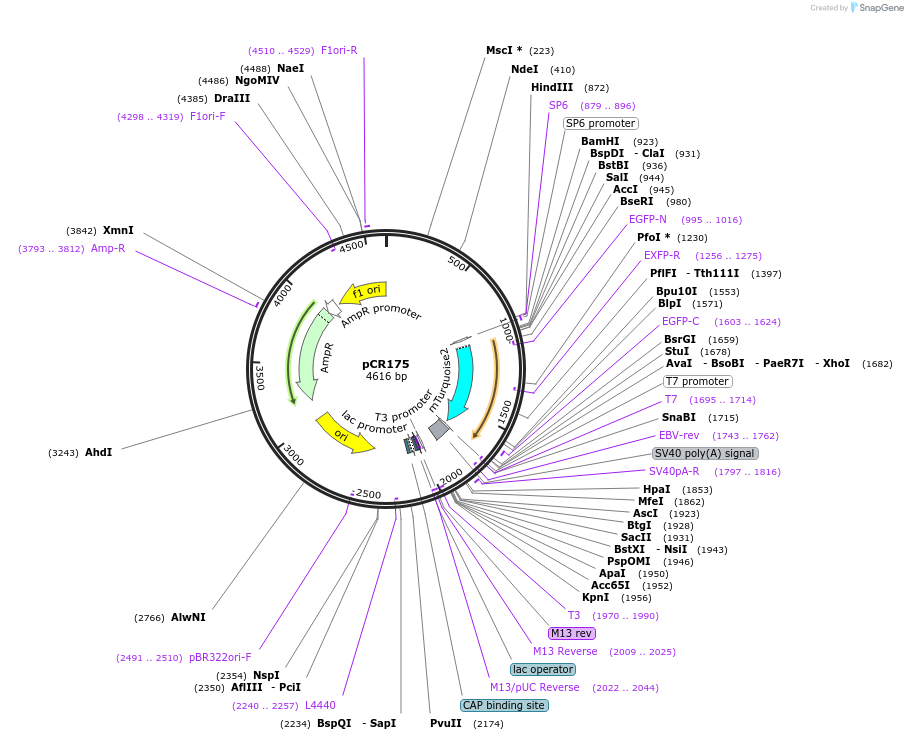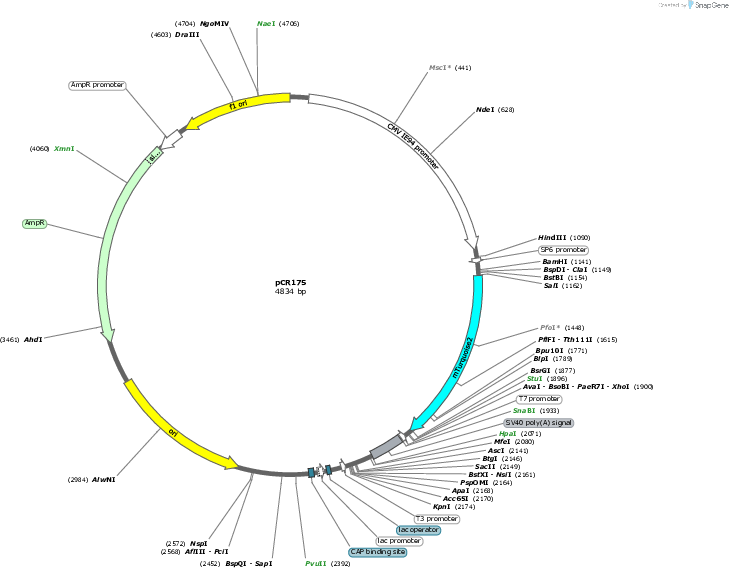pCR175
(Plasmid
#240640)
-
PurposeTemplate for in vitro transcription of mTurquoise2 mRNA using SP6 polymerase.
-
Depositing Lab
-
Publication
-
Sequence Information
Ordering
| Item | Catalog # | Description | Quantity | Price (USD) | |
|---|---|---|---|---|---|
| Plasmid | 240640 | Standard format: Plasmid sent in bacteria as agar stab | 1 | $89 | |
Backbone
-
Vector backbonepCS107
-
Backbone manufacturerBaker et al., 1999
- Backbone size w/o insert (bp) 4108
- Total vector size (bp) 4834
-
Vector typeVertebrate gene expression and general in vitro transcription.
Growth in Bacteria
-
Bacterial Resistance(s)Ampicillin, 100 μg/mL
-
Growth Temperature37°C
-
Growth Strain(s)DH5alpha
-
Copy numberHigh Copy
Gene/Insert
-
Gene/Insert namemTurquoise2
-
SpeciesSynthetic
-
Insert Size (bp)719
-
GenBank IDKM670033.1
- Promoter SP6
Cloning Information
- Cloning method Gibson Cloning
- 5′ sequencing primer Pcmv_end_seq_fwd (GCAAATGGGCGGTAGGCG)
- 3′ sequencing primer M13 Reverse (-27) (CAGGAAACAGCTATGAC)
- (Common Sequencing Primers)
Resource Information
-
Supplemental Documents
-
A portion of this plasmid was derived from a plasmid made bypCS107 backbone: Baker JC, Beddington RSP, Harland RM. 1999. Wnt signaling in Xenopus embryos inhibits Bmp4 expression and activates neural development. Genes Dev. 13(23):3149–3159. doi:10.1101/gad.13.23.3149. mTurquoise2: Goedhart J, Von Stetten D, Noirclerc-Savoye M, Lelimousin M, Joosen L, Hink MA, Van Weeren L, Gadella TWJ, Royant A. 2012. Structure-guided evolution of cyan fluorescent proteins towards a quantum yield of 93%. Nat Commun. 3(1):751. doi:10.1038/ncomms1738. Plasmid mScarlet-I-mTurquoise2 (Addgene plasmid # 98839): Mastop M, Bindels DS, Shaner NC, Postma M, Gadella TWJ, Goedhart J. 2017. Characterization of a spectrally diverse set of fluorescent proteins as FRET acceptors for mTurquoise2. Sci Rep. 7(1):11999. doi:10.1038/s41598-017-12212-x.
Terms and Licenses
-
Academic/Nonprofit Terms
-
Industry Terms
- Not Available to Industry
Trademarks:
- Zeocin® is an InvivoGen trademark.
These plasmids were created by your colleagues. Please acknowledge the Principal Investigator, cite the article in which the plasmids were described, and include Addgene in the Materials and Methods of your future publications.
-
For your Materials & Methods section:
pCR175 was a gift from John Pringle (Addgene plasmid # 240640 ; http://n2t.net/addgene:240640 ; RRID:Addgene_240640)







